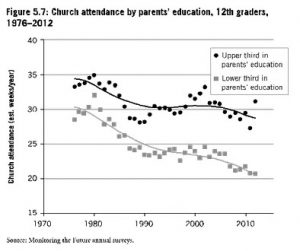 As I read W. Bradford Wilcox’s recent Acts of Faith article in the Washington Post I found myself drawn to a graph illustrating a decline in church attendance. While the decline in American church attendance in America since the mid-1970s is well documented and much discussed by lay religious folks and scholars alike, few have given any real consideration to how the rate of decline differs based on education.
As I read W. Bradford Wilcox’s recent Acts of Faith article in the Washington Post I found myself drawn to a graph illustrating a decline in church attendance. While the decline in American church attendance in America since the mid-1970s is well documented and much discussed by lay religious folks and scholars alike, few have given any real consideration to how the rate of decline differs based on education.
A few years ago I shared W. Bradford Wilcox’s finding that “since the 1970s, white Americans with no more than a high school diploma have been leaving the pews twice as fast as other Americans”
The graph in his new Washington Post piece displays the decline in how many weeks per year the average 12th grader attended worship in a year by charting the decline since the mid-1970s for the upper third based on parents’ education and the lower third. The rate of decline has been significantly more rapid for the lower third. The higher group has declined from just under 35 weeks a year to just under 30 weeks a year while the lower group has declined from 30 weeks a year to just over 20 weeks a year.
So What?
Wilcox cites Robert Putnam’s new book – Our Kids: The American Dream in Crisis (March 2015) – to argue that those children who are most likely to benefit from the belonging and hope found in religious involvement are increasingly the least likely to have such experiences.
- What people, groups, teams, committees, ministries, etc. within your local congregation do you feel most need to know about this information?
- Will you pass it on to one or more of the people or groups on your list?